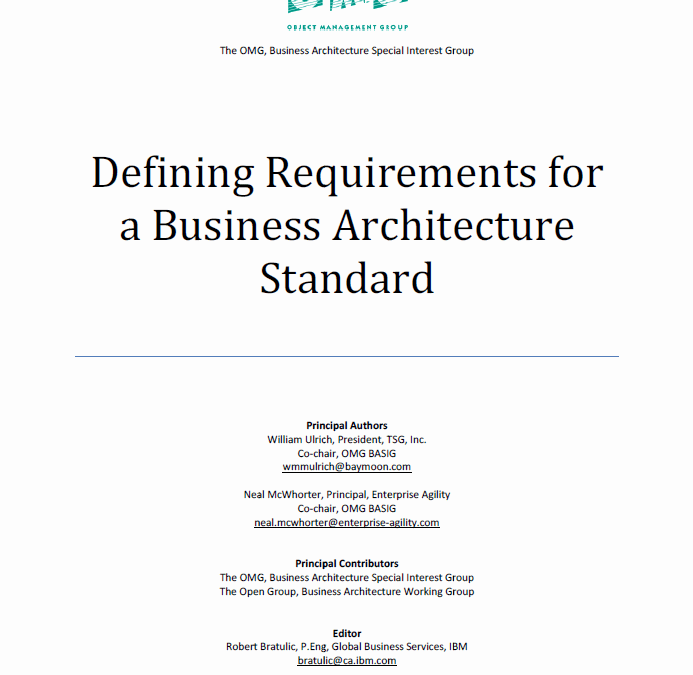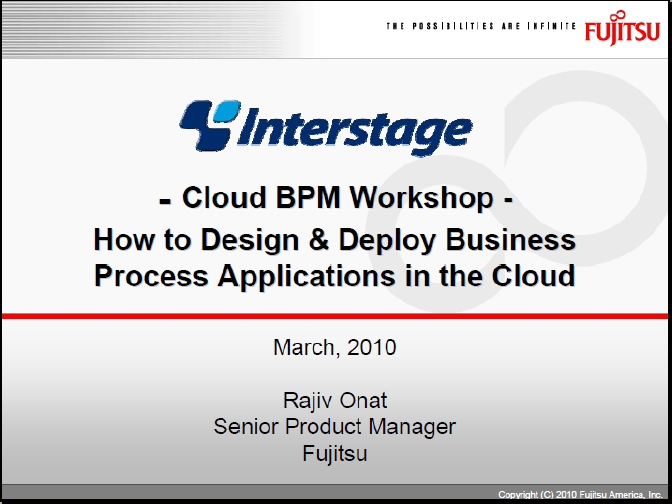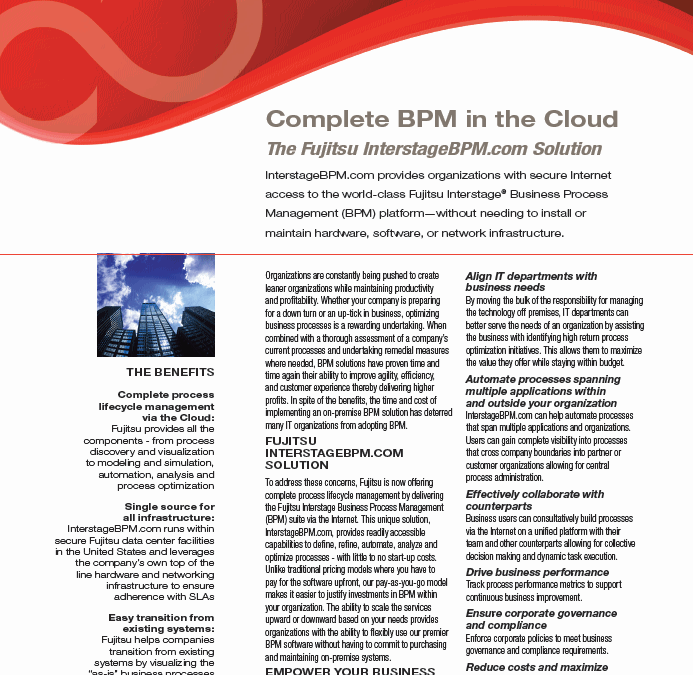Home / Resources
Resources
Discover a Wealth of BPM Knowledge and Expertise at BPMInstitute.org!

Defining Requirements for a Business Architecture Standard
As enterprises continue to deploy business architecture capabilities, the need for a consistent, cohesive understanding of business architecture is growing increasingly critical. Frameworks, methodologies and tools will continue to evolve, but practices and technologies must be based on a solid foundation. This white paper promotes a common understanding of business architecture. The discussion defines the essence of the business architecture, how it relates to IT architecture, the importance of business architecture standardization, and a roadmap for achieving standardization.

Monitoring SOA End to End
For those organisations that have moved into live running of business applications based on SOA, one of the (many) current headaches is monitoring and managing end to end transactions. Although application, network and infrastructure monitoring tools have been around for many years, the loosely coupled nature of SOA presents some challenges in providing the transaction visibility, integrity and recovery capability that mainframe users have enjoyed since the 1970s.

Business Architecture Community Webcast: Advancing BA in 2010
Join us for this LIVE webcast to share your opinion on our 2010 editorial calendar, find out how to contribute to the Business Architecture Body of Knowledge and learn about the new benefits you have through BusinessArchitectureInstitute.org.
This webcast includes:
- Discuss the needs of the business architecture community and establish goals and objectives for the 2010 editorial calendar on BusinessArchitectureInstitute.org
- Gain an understanding of the enhanced capabilities that the Business Architecture Community will receive through our partnership withBusinessArchitectureIn
Join us for this LIVE webcast to share your opinion on our 2010 editorial calendar, find out how to contribute to the Business Architecture Body of Knowledge and learn about the new benefits you have through BusinessArchitectureInstitute.org.
This webcast includes:

What Makes a Great Business Architect?
“What makes a great business architect?”
“My organization is looking to hire business architects. What should we be looking for?”
“How do I know my business architect is doing the ‘right’ things?”

Business Architecture: The Complete View of Business
In recent years, two business evaluation methodologies have competed for center stage: Business Process Management and Business Rules Management (or, as some are now calling it, “Business Decision Management”). Currently, there is a new methodology, Business Architecture, which is attracting attention.
Why is Business Architecture generating such interest?

The Watermelon Box
“Innovation” does not always mean “new technology”
There’s almost nothing better on a hot summer day, especially at a picnic, than a nice, cold, juicy watermelon. The problem with watermelons, however, is that they are big, oblong objects that usually don’t fit in the fridge and often take up the whole ice chest (occasionally, you can find a smaller, volleyball-shaped melon, but even those take up a bunch of space).

Maturity & Business Architecture
Background “Maturity” is a term that has become more and more prominent in business since the 1980s, when the United States Air Force funded a study at the Carnegie-Mellon Software Engineering Institute to create a model for the military to use as an objective evaluation of software subcontractors.

Business Architecture and Portfolio Management
Fiona S., the chief operating officer of an multi-national industrial parts manufacturer, listens to Wayne, the vice-president of sales, present his group’s capital investment proposals for the coming year. Among the planned initiatives Wayne describes is the development of an online sales quoting tool. As Fiona listens to Wayne run through the list of proposed features that the tool will include, a thought occurs to her:
Didn’t the Customer Service group propose a CRM initiative that touched on similar things just last week?

When BPM is Not Done Right
Much of today’s Business Process Management (BPM) consideration and effort tends to focus more on the technology aspect. Truly effective BPM, however, cannot focus entirely on technology.
In this article, we will explore three aspects of BPM that do not get as much attention as they should: the human-side perspective, the need to implement incrementally, and the place of BPM within the larger context of Business Transformation.

Selling Business Architecture Internally – The Value-based Approach
Too often, as business architects, we face internal barriers while driving adoption of business architecture practices within an organization. We are confronted with confused looks, competing priorities, tight budgets, and hearing frequently that “we don’t need another documentation methodology.” All are fair points if the perception of business architecture is truly that it is only a documentation methodology. Business Architecture, however, is much more. It is easy for any business architect to get preoccupied in the daily routine of producing business

Optimizing the Address Change Process
In this article we will examine a fairly common business process, customer address change, to outline a range of alternative approaches to business process management and improvement, from a low-tech, manual “quick fix” to a service-oriented architecture (SOA) approach.
The Scenario

Facilitation: Key Ingredients for Success
Anyone who has been in the business world for a while has probably experienced a few painful facilitation sessions, plagued by conversations going in circles and little to nothing being accomplished. With today’s reality of back-to-back and double-booked meetings, the value of participants’ time has never been greater. The good news is that meeting time can be better spent, resulting in quicker decision making and less time to implementation. How? There are two key ingredients to achieve an effective facilitation session – a good facilitator and careful sess

Cloud BPM Workshop – How to Design & Deploy Business Process Applications in the Cloud
Organizations are constantly being pushed to create leaner organizations while maintaining productivity and profitability.To address this situation, Fujitsu is now offering complete process lifecycle management via the Cloud.
Join us for a demonstration and discussion around how to quickly build business process applications in the Cloud with the Interstage Cloud BPM offering. During this session, we will walk you through:
1. Getting started by creating your own secure space on the platform

Complete BPM in the Cloud
The Fujitsu InterstageBPM.com SolutionInterstageBPM.com provides organizations with secure Internet access to the world-class Fujitsu Interstage(r) Business Process Management (BPM) platform – without needing to install or maintain hardware, software, or network infrastructure.

The Value of Relationships
When you grapple with a new idea, where do you start? Most people concentrate on the whole or the parts – either the entity that is the overall idea or the entities that compose it. That we approach ideas in this manner and don’t think about them instead as sets of relationships among components seems to be natural. Relationships, if we get around to them at all, are secondary considerations.

Is SOA really a failure?
I recently came across an article titled “SOA is dead, long live services!” It grabbed my attention (in fact, it is subject of a very lively discussion in the blogosphere), and got me thinking about how SOA has come to reach the “trough of disillusionment” stage. I decided to put some thoughts together, a sort of “a posteriori” analysis of my own experiences. So, why do SOA projects fail? We have the usual litany of suspects: market over-hype, vendor “marketecture”, lack of skilled resources, funding, etc. But that would be too easy, maybe even a cop out.

Barriers to success: Decision Management
Despite the growing number of success stories testifying to the positive business-transforming effects of Decision Management, many companies struggle to reach an implementation maturity level that generates continual value.

Risk and Compliance – embedding specific requirements in the Target State Business Architecture
Risk and Compliance
Many companies across the globe are facing up to a whole new world where risk and compliance assurance must now be supported by reliable controls over which the level of transparency required to be provided by the business to the governance process is considerably onerous.
Furthermore the requirements on the company are written into statutory obligations and carry heavy penalties for those that fail to deliver.

What’s Up With Business Architecture Vendors?
Business architecture teams are making significant inroads by providing business executives with the organizational transparency required to diagnose and take on critical business challenges. As business architects continue to collect, organize, aggregate and visualize cross-functional, cross-disciplinary business knowledge, they require a business architecture knowledgebase.

Evolving the Decision Model with Views
This article assumes knowledge of the Decision Model. If you are not already familiar with the theory of the Decision Model you can download a brief primer from www.TheDecisionModel.com.)













